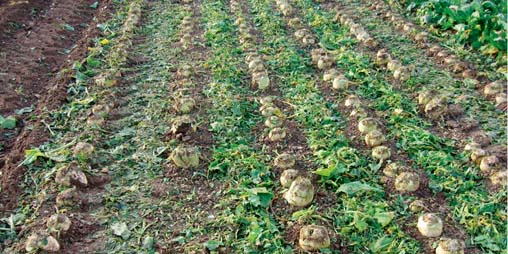VIDEO: Coin offers clue to new whole beet harvesting

With British Sugar and the NFU agreeing to drop the often controversial crown or “top tare” sampling system from the coming campaign, the coin concept highlights the extra potential profit and provides a practical tip to harvester operators.
Robin Limb, British Sugar central agriculture manager, acknowledges that the long-practised manual crown topping at factories was “never a happy marriage”, even though growers have been compensated for their potential sugar losses for about 10 years.
“The new whole beet harvesting system is a step forward in openness and transparency,” says Mr Limb.
See a Ropa harvester with micro-topper in action in Germany
From this year a fixed crown tare adjustment of 6.77% will be applied to all factory deliveries, and all non-green beet material will attract the full beet price.
The adjustment is based on 11 years’ data and a trial last campaign which showed that overall sugar content fell by 0.185% when switching to whole beet harvesting.
Another trial will be done during 2011-2012 to determine a final fixed crown adjustment figure for all crops from 2012-2013.
Mr Limb says the big plus for growers is that the system, introduced to be “cost neutral”, could raise sugar yields by up to 5% and so boost profits by up to £80/ha.
That’s where the £2 coin idea can help, he suggests. The aim should be to adjust the harvester’s topping mechanism to remove only leaves and petioles – leaving too much green material risks factory rejections, he warns.
“There may still be some evidence of greening but the cut surface of the beet should be no bigger than a £2 coin.”
That may be easier to achieve on some machines than others, he admits. “But it does mean that you should be able to raise the knife a bit to a win/win position. However, some adjustment to feeler wheel/knife distances is also likely to be needed.”
British Sugar staff will be available to offer advice on setting up harvesters under the new regime, he notes.
Looking ahead, he expects the change will lead to new machines being developed to remove green material while minimising beet top losses.
On the continent, where whole beet harvesting has been practised in several countries for a few years, such machines are already in action and are now available in the UK, notes Nigel Mountain of CTM Harpley, importer of Ropa harvesters.
These can be fitted with the company’s parallel-linkage micro-topping system designed specifically for whole beet lifting.
“We still don’t know exactly what parameters will be required here,” says Mr Mountain. “But the crux of the matter is that nearly all of this year’s 150 new ROPA euro Tiger harvesters sold worldwide have been fitted with Micro Topping 2.”
NFU sugar board member and Farmers Weekly Arable Farmer of the Year John Goodchild, who contract harvests about 2,000ha for 20 growers, including 265ha of his own beet at Bartlow Estate, Cambridgeshire, stresses that adjusting to the new regime must not hamper harvest progress.
“We’ve got to have something which doesn’t slow the job, and it’s not just a case of lifting the knife.”
He welcomes the payment change – even though it has involved capital outlay; and he has had both his six-row Ropa machines adapted for micro-topping.
“It cost about £1,000 per row to modify them, but the economics do stack up.”
Assuming only a 4% sugar yield boost on his own crop from whole beet lifting and a yield of 75t/ha (he has occasionally achieved 100t/ha), the extra return should be over £18,000 for a cost of about £6,000, he calculates.
Fellow board member Robert Law relies on contractors to lift his 170ha of sugar beet in Hertfordshire and Nottinghamshire.
“Their Vervaet harvesters can be adjusted, up to a certain point, for whole beet lifting – they can leave more top on, but it’s not really enough. It’s an improvement but not ideal.
“It’s likely over the next season or two that manufacturers will modify toppers on existing machines, and new models will have purpose-built topping mechanisms to cope with whole beet harvesting.”

